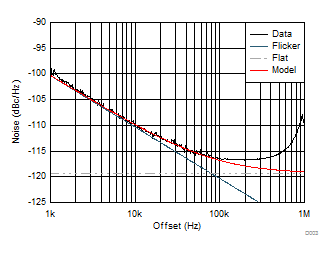ZHCSEK3G December 2015 – August 2022 LMX2592
PRODUCTION DATA
- 1 特性
- 2 应用
- 3 说明
- 4 Revision History
- 5 Pin Configuration and Functions
- 6 Specifications
- 7 Detailed Description
-
8 Application and Implementation
- 8.1
Application Information
- 8.1.1 Optimization of Spurs
- 8.1.2 Configuring the Input Signal Path
- 8.1.3 Input Pin Configuration
- 8.1.4 Using the OSCin Doubler
- 8.1.5 Using the Input Signal Path Components
- 8.1.6 Designing for Output Power
- 8.1.7 Current Consumption Management
- 8.1.8 Decreasing Lock Time
- 8.1.9 Modeling and Understanding PLL FOM and Flicker Noise
- 8.1.10 External Loop Filter
- 8.2 Typical Application
- 8.3 Power Supply Recommendations
- 8.4 Layout
- 8.1
Application Information
- 9 Device and Documentation Support
- 10Mechanical, Packaging, and Orderable Information
封装选项
请参考 PDF 数据表获取器件具体的封装图。
机械数据 (封装 | 引脚)
- RHA|40
散热焊盘机械数据 (封装 | 引脚)
- RHA|40
订购信息
8.1.9 Modeling and Understanding PLL FOM and Flicker Noise
Follow these recommended settings to design for wide loop bandwidth and extract FOM and flicker noise. The flat model is the PLL noise floor modeled by: PLL_flat = PLL_FOM + 20 × log(Fvco/Fpd) + 10 × log(Fpd / 1 Hz). The flicker noise (also known as 1/f noise) which changes by –10dB / decade, is modeled by: PLL_flicker (offset) = PLL_flicker_Norm + 20 × log(Fvco / 1 GHz) – 10 × log(offset / 10k Hz). The cumulative model is the addition of both components: PLL_Noise = 10*log(10PLL_Flat / 10 + 10PLL_flicker / 10). This is adjusted to fit the measured data to extract the PLL_FOM and PLL_flicker_Norm spec numbers.
| PARAMETER | VALUE |
|---|---|
| PFD (MHz) | 200 |
| Charge pump (mA) | 12 |
| VCO frequency (MHz) | 5400 |
| Loop bandwidth (kHz) | 2000 |
| Phase margin (degrees) | 30 |
| Gamma | 1.4 |
| Loop filter (2nd order) | |
| C1 (nF) | 0.01 |
| C2 (nF) | 0.022 |
| R2 (kΩ) | 4.7 |
 Figure 8-9 FOM and Flicker Noise
Modeling
Figure 8-9 FOM and Flicker Noise
Modeling